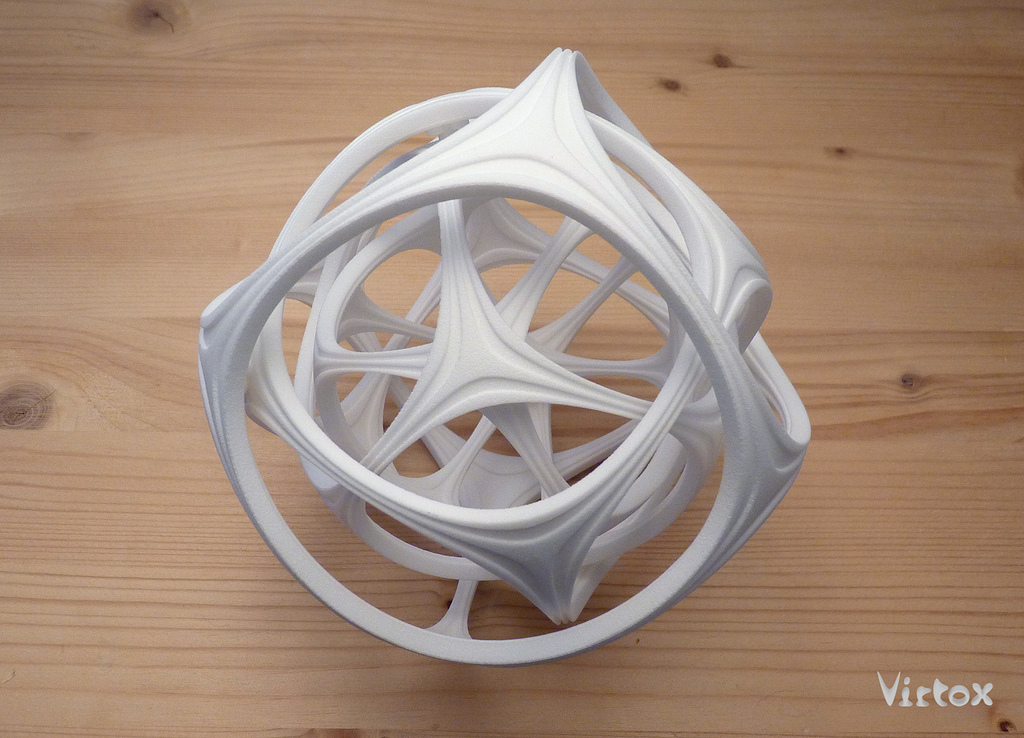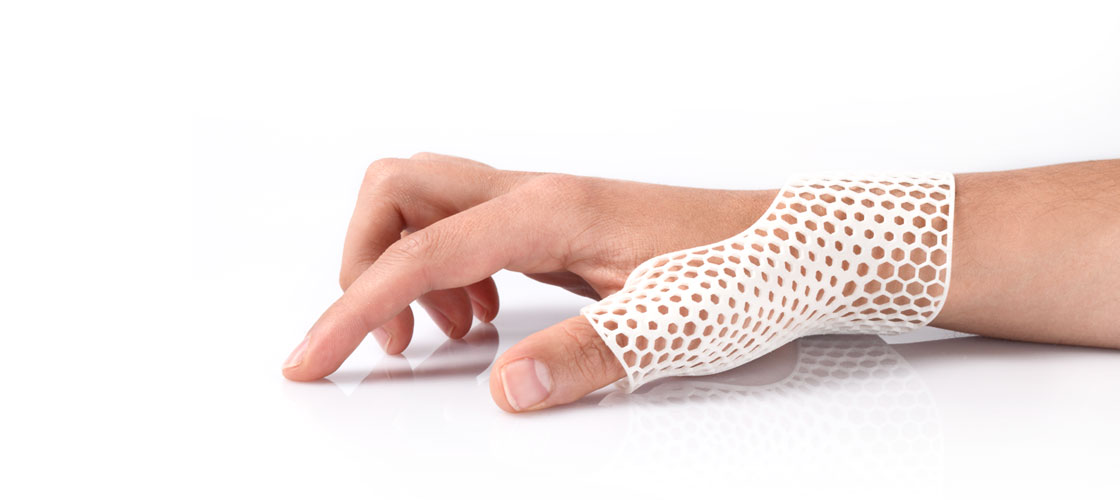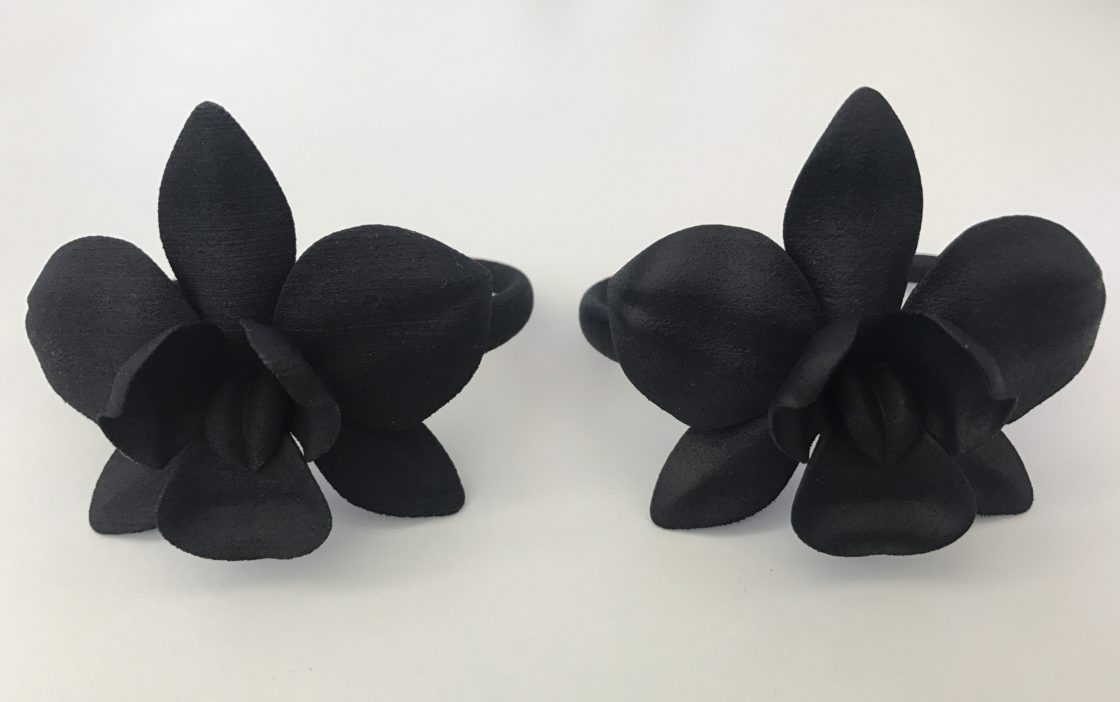
Read on to find out more about:
- How 3D printed nylon thermoplastics allow Shapeways customers to achieve their vision.
- Why nylon thermoplastics are useful in both rapid prototyping and 3D printing functional parts.
- Why materials like Nylon 12 [Versatile Plastic] are suitable for so many applications.
- How Shapeways uses Selective Laser Sintering (SLS) and Multi Jet Fusion to 3D print popular, high-quality plastics.
Nylon Plastics Continue to Reign
The history of nylon plastics is a long one, and it begins with traditional manufacturing. Nylon 12 serves as an exemplary model of a polyamide discovered for use in processes like injection molding, with many identical advantages offered when it is used in 3D printing too. This includes durability, flexibility, and incredible versatility, along with more specific features like high tensile strength, abrasion resistance, and thermal stability.
Polyamides like nylon offer a high melting point, along with the ability to create flexible parts with thinner structures, but more rigid pieces with thicker parts. Other materials like PA 12 Glass Beads (PA12GB) are fortified to allow for even greater stiffness and product strength in flat or large parts that may be especially susceptible to warping.
Shapeways has been privileged over the years to collaborate with innovative customers involved in very impressive work. Highlighting materials like Nylon 12 [Versatile Plastic], companies like BeeHero have been able to streamline technology for beekeepers and farmers, 3D printing sensor housings for smart hives created to improve pollination. Companies like Verner Architects have used these materials for unique designs like a six-foot-long bathroom vanity meant to stand the test of time. Tilt Hydrometer has also used Nylon 12 [Versatile Plastic] for both prototyping and 3D printing end-use parts for monitoring the fermentation process in brewing craft beer.

Advanced Technology for Advanced Materials
SLS materials are produced using EOS machines and Multi Jet Fusion materials are produced using HP machines. While the material properties are similar, they are each slightly different, making each more suited for one specific application over another.
Nylon 3D Printed with Selective Laser Sintering
One of the original 3D printing processes, Selective Laser Sintering (SLS) was created in the ‘80s by Dr. Carl Deckard and Dr. Joe Beaman, associated with both University of Texas at Austin and the Defense Advanced Research Projects Agency (DARPA). And although the 3D printing industry has continued to evolve at a rapid pace—and into an industry valued in the billions—SLS technology still prevails, at the top of the additive manufacturing hierarchy as one of the most powerful processes.
Shapeways relies on Selective Laser Sintering (SLS) technology to 3D print the following materials:
- Nylon 12 [Versatile Plastic]
- Nylon 11 [PA11(SLS)]
- Nylon 6 Mineral Filled (PA6 MF)
Nylon 12 [Versatile Plastic] is the most widely used 3D printed plastic due to its balanced property profile. These balanced properties, including high strength and good chemical resistance, make it a great multipurpose material suitable for a wide range of functional applications. Machines producing SLS PA12 have the largest build platform, allowing larger parts to be printed.
Several finishes are also available:
- Natural: This finish has a slightly rough surface and a matte finish.
- Processed: This finish removes some material to create a smoother surface.
- Premium: This is a smooth finish with good scratch resistance.
- Smooth: This finish has a smooth surface and slight shine, created using a physio-chemical vapor process.
Colors: Versatile Plastic is naturally white. Shapeways also offer Black, Pink, Red, Orange, Yellow, Green, Blue, and Purple. Note: Colors other than White are dyed and will wear through over time with handling.

Nylon 11 [PA11(SLS)] is the most flexible nylon material due to its much higher elongation at break. It also has slightly higher strength than the other materials. This combination of high strength and good elongation at break makes it the most impact-resistant material of the four choices. Popular applications include sports equipment, orthotics and prosthetics, and hinges, where high ductility is important. PA11 also has higher temperature resistance and is based on renewable resources, therefore making it more environmentally friendly.
A natural white finish is available for this material.
Nylon 6 Mineral Filled (PA6 MF) is a unique material, used in applications requiring high stiffness, strength, and heat stability. Mineral-filled reinforcement offers properties similar to injection molded parts—but without the added time and expense required in using that technology. This material is suitable for applications like automotive, including structural parts and functional prototypes.
Parts printed with Nylon 6 Mineral Filled (PA6 MF) are available in the natural black finish.
Nylon 3D Printed with Multi Jet Fusion
Multi Jet Fusion falls into the powder-based category, but uses an inkjet array to move back and forth depositing adhesive agents onto the powder bed, where the nylon powder particles are then melted with thermal heat.
HP released Multi Jet Fusion technology in 2016 with great fanfare. Previous to the much-awaited release, there was tremendous buzz about a powerful new 3D printer on the horizon, and one capable of exponentially faster production than anything currently on the market at the time. HP did not miss the mark at all either, bringing forth a printer that took processes like Selective Laser Sintering (SLS) and Binder Jetting one step further, doing away with lasers and binders, and using two different types of liquid agents during the printing process for jobs requiring higher detail and better surface finish.
Shapeways relies on Multi Jet Fusion to 3D print the following materials:
Nylon 12 [MJF Plastic PA12] has very similar properties to Nylon 12 [Versatile Plastic] produced with SLS; however, due to a slightly different printing technology, it has more consistent, isotropic properties throughout parts. MJF PA12 also has a slightly higher elongation at break. Increased elasticity makes this material more resistant to breakages and as a result, it is suitable for 3D printing parts with thinner wires and wall features are able to be produced.
Multi Jet Fusion is printed at a lower layer thickness over SLS PA12 providing better resolution of small details too. Several finishes are available:
- Gray: Medium gray with a matte and slightly grainy surface finish.
- Black: Dyed black with a matte and slightly grainy surface finish.
- Black Smooth: Dyed black with a smooth and slightly glossy surface finish.
Nylon 12 Glass Beads [MJF Plastic PA12GB] is filled with 40% glass bead particles and as a result, is a much stiffer material. The higher rigidity makes this well-suited for structural parts and housings that will remain stiff and strong over time. It will hold up better over time, specifically for applications that may be exposed to friction and wear, such as tooling and molds. The following finishes are available:
- Gray: Natural gray finish, blasted with oxide beads and air.
- Dark Gray: Blasted with oxide beads and air, finished with a dark gray color.
With such an abundance of 3D printing materials available today, the key is to recognize the advantages of suitable products and finishes for specific project requirements, and become informed on how different additive manufacturing technology measures up too.
About Shapeways
Shapeways has worked with over 1 million customers in 160 countries to make over 21 million parts! Read about case studies, find out more about Shapeways solutions, and get instant quotes here.
Contact Shapeways now to enjoy the benefits of advanced technology and materials for 3D printing with accuracy, complex detail, and no limits in terms of mass customization or single part orders.

